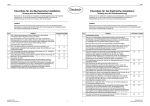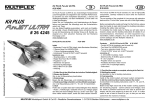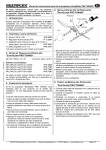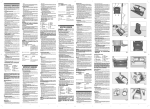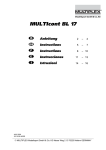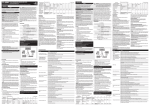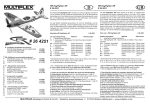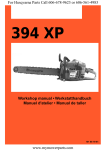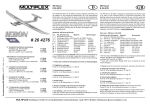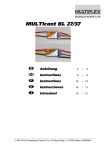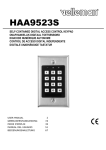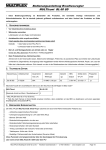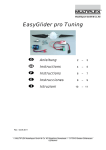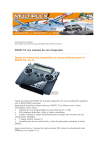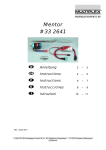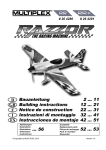Download MULTIcont BL-17
Transcript
MULTIcont BL-17, -17/II, -27/II, -37/II, -54 Anleitung 2 – 5 Instructions 6 – 9 Instructions 10 – 13 Instrucciones 14 – 17 Istruzioni 18 – 21 Rev.: 03.04.08 MULTIPLEX Modellsport GmbH & Co.KG • Westliche Gewerbestraße 1 • D-75015 Bretten (Gölshausen) • www.multiplex-rc.de Bedienungsanleitung Brushlessregler MULTIcont BL-17 / BL-17/II / BL-27/II / BL-37/II / BL-54 ! Diese Bedienungsanleitung ist Bestandteil des Produktes. Sie beinhaltet wichtige Informationen und Sicherheitshinweise. Sie ist deshalb jederzeit griffbereit aufzubewahren und beim Verkauf des Produktes an Dritte mitzugeben. BL-37/II BL-54 Best.-Nr.: # 7 2276 # 7 2277 37 A 54 A Dauerstrom max.: Taktfrequenz: 13 kHz 1. SICHERHEITSHINWEISE Empfängerstromversorgung (BEC): max. 3S LiPo oder 9 Zellen NiXX ! Vor Inbetriebnahme Anleitung lesen Zellenzahl bei deaktiviertem BEC: max. 3S LiPo oder 12 Zellen NiXX ! Wärmestau vermeiden Luftzirkulation um den Regler nicht behindern BEC-Spannung: ! Antriebsakku nicht verpolt anschließen Falsch gepolte Akku-Anschlusskabel zerstören den Regler sofort! Deshalb: • rotes Kabel an den PLUS-Pol (+) • schwarzes Kabel an den MINUS-Pol (-) Anleitung MULTIcont BL-17 / BL-17/II / BL-27/II / BL-37/II / BL-54, # 82 5559 (08-02-11/DAMA) • Irrtum und Änderung vorbehalten! • © MULTIPLEX MULTIcont: ! Bei Löt- und Montagearbeiten am Antrieb oder am Regler Immer den Akku abtrennen (Kurzschluss / Verletzungsgefahr!) ! Beim Probebetrieb bzw. Betrieb beachten Antrieb nicht in der Hand laufen lassen, Modell sicher befestigen. Prüfen Sie, ob ausreichend Platz zum Drehen der Luftschraube vorhanden ist. Gegenstände, die angesaugt oder weggeblasen werden können (Kleidungsstücke, Kleinteile, Papier, usw.) aus der Nähe der Luftschraube entfernen. Sich niemals vor oder in der Rotationsebene der Luftschraube aufhalten (Verletzungsgefahr!). 2. TECHNISCHE DATEN MULTIcont: Best.-Nr.: Dauerstrom max.: BL-17 BL-17/II BL-27/II # 7 2274 # 7 2280 # 7 2275 17 A 17 A 27 A Taktfrequenz: 13 kHz Empfängerstromversorgung (BEC): max. 3S LiPo oder 9 Zellen NiXX Zellenzahl bei deaktiviertem BEC: max. 3S LiPo oder 12 Zellen NiXX BEC-Spannung: 5,0 V BEC-Verlustleistung: max. 1,5 W max. 3,0 W max. 3,0 W BEC-Strom: max. 1,5 A max. 3,0 A max. 3,0 A Abmessungen in mm: ca. 26x17x8 ca. 36x23x9 ca. 36x24x11 Gewicht mit Kabeln: ca. 9 g ca. 22 g ca. 23 g 5,0 V BEC-Verlustleistung: max. 3,0 W max. 3,0 W BEC-Strom: max. 3,0 A max. 3,0 A ca. 38x26x10 ca. 51x28x9 ca. 30 g ca. 37 g Abmessungen in mm: Gewicht mit Kabeln: Maximal anschließbare Servozahl bei MULTIcont BLReglern im BEC-Betrieb** MULTIcont: BL-17/II BL-27/II BL-37/II BL-54 BL-17 NiXX-Zellen: bis 6 bis 9 bis 6 bis 9 LiPo-Zellen: 2S 3S 2S 3S Maximalzahl Mikro / Standard Servos*: 4 3 5 4 Maximalzahl High Torque Servos: 3 4 3 2 * MULTIPLEX Servos des Typs Nano-S oder Tiny-S. ** Übersteigt die Anzahl der im Modell angeschlossenen Servos die oben angegebene Maximalzahl, müssen Sie zwingend das BEC-System deaktivieren und einen separaten Empfängerakku verwenden (Î 7.). 3. BESONDERE EIGENSCHAFTEN MULTIPLEX MULTIcont BL-Regler zeichnen sich durch eine Reihe interessanter Features aus: • programmierbare Parameter - Akkutyp: LiPo oder NiXX - Bremse: EIN oder AUS - Motor-Drehrichtung: ändern • BEC (Battery Eliminator Circuit) Empfängerstromversorgung aus dem Antriebsakku • Start-Sicherheitssystem verhindert ungewollten Motoranlauf beim Anstecken des Akkus • automatische Unterspannungsabschaltung mit erneuter Startmöglichkeit (Reset-Funktion) für LiPo- und NiXXZellen • Motorabschaltung bei massiven Funkstörungen oder fehlendem Sendersignal MULTIPLEX Modellsport GmbH & Co.KG • Westliche Gewerbestraße 1 • D-75015 Bretten (Gölshausen) • www.multiplex-rc.de Seite 1/4 Bedienungsanleitung Brushlessregler MULTIcont BL-17 / BL-17/II / BL-27/II / BL-37/II / BL-54 4. VERDRAHTUNG 5. INBETRIEBNAHME ! Hinweis: Informationen zu Lötarbeiten Zur Montage einiger Varianten der MULTIcont BL-Regler sind Lötarbeiten erforderlich. Lötarbeiten erfordern ein Mindestmaß an Sorgfalt, da hiervon die Betriebssicherheit maßgeblich abhängt: MULTIcont BL-Regler sind im Lieferzustand auf den Betrieb mit 2S- oder 3S-LiPo-Akkus eingestellt, die Bremse ist AUS. • nur für Elektronik-Lötarbeiten geeignetes Lötzinn verwenden 1. Inbetriebnahme der MULTIcont BL-Regler 1.1 Bei programmierbarer Fernsteuerung: Servoweg für Gas / Motor beidseitig auf 100% einstellen 1.2 Gasknüppel (und ggfs. dessen Trimmung) am Sender in Motor-AUS-Position 1.3 Sender EIN 1.4 Vollen Antriebsakku anschließen • kein säurehaltiges Lötfett verwenden • zu verlötende Teile nicht übermäßig, aber ausreichend erhitzen (das Zinn muss fließen) Anleitung MULTIcont BL-17 / BL-17/II / BL-27/II / BL-37/II / BL-54, # 82 5559 (08-02-11/DAMA) • Irrtum und Änderung vorbehalten! • © MULTIPLEX • gegebenenfalls jemanden mit Löterfahrung hinzuziehen • alle Lötstellen und blanke Kabelstellen sorgfältig isolieren (z.B. mit Schrumpfschlauch) Anschluss der Akku-Steckverbindung Die Akku-Anschlussstecker werden an den zwei Kabeln angeschlossen (rot = +, schwarz = -). Kabel möglichst kurz halten. Kürzen Sie die Akku-Anschlusskabel ggfs. auf die erforderliche Länge. Schieben Sie ein Stück Schrumpfschlauch auf jedes Kabel und verschrumpfen Sie die Lötstellen nach den Lötarbeiten. Beim Anlöten der Akku-Anschlussstecker auf die korrekte Polung zum Akku achten. Falschpolung führt unweigerlich zur sofortigen Zerstörung des Reglers! Anschluss des Reglers an den Motor Der Motor wird auf der Seite mit den drei herausgeführten Kabeln angeschlossen. Löten Sie die zum Motor-Stecksystem passenden Buchsen an und isolieren Sie nach den Lötarbeiten die Lötstellen mit Schrumpfschlauch. Kabel möglichst kurz halten. Für eine evtl notwendige Motor-Drehrichtungsumkehr tauschen Sie einfach zwei der drei zum Motor führenden Zuleitungen oder ändern die Motor-Drehrichtung durch Programmierung (Î 6.4.). Anschluss des dreiadrigen Anschlusskabels (UNIStecksystem) am Empfänger Stecken Sie das dreiadrige Empfänger-Anschlusskabel des Reglers in den Empfängereingang für die Motorregelung: - bei MULTIPLEX-Fernsteuerungen i.a. an Kanal 4 = Gas / Motor - bei HiTEC-Fernsteuerungen an Kanal 3 = Gas / Motor Pinbelegung Minus-Pol (−) ⇒ Aufsteigende Tonfolge ⇒ Zwei oder drei Pieptöne signalisieren im LiPo-Modus die Erkennung eines 2S- oder 3S-LiPo-Akkus ⇒ Zwei aufsteigende Tonfolgen ⇒ Regler ist betriebsbereit In der Motor-AUS-Position hören Sie alle ca. 30 Sekunden einen einzelnen Piepton. Dieser erinnert Sie daran, dass Ihr Modell eingeschaltet ist. ! Hinweise: Programmierbare Parameter Sollten Sie NiXX-Zellen nutzen, die Bremse einschalten (z.B. für Klappluftschrauben) oder die Drehrichtung des Motors umkehren wollen, so folgen Sie bitte dem Kapitel Programmierung (Î 6.). Anlaufschutz MULTIcont BL-Regler werden erst scharf, nachdem der Knüppel in die Motor-AUS-Position gebracht wurde und die akustische Rückmeldung hinsichtlich der Betriebsbereitschaft erfolgt ist. Immer Reichweitentest durchführen Führen Sie vor dem Flug immer einen Reichweitentest mit eingeschalteter Fernsteuerung durch. Dabei prüfen Sie insbesondere bei Vollgas und Halbgas, ob sich die Reichweite im Vergleich zu Motor-AUS reduziert und ob Störungen auftreten. Achten Sie auch auf die angeschlossenen Servos: Zittern der Servos oder ungesteuerte Ausschläge deuten auf Störungen hin! braun Plus-Pol (+) rot Impuls ( ) orange Schließen Sie keinen zusätzlichen Empfängerakku an den Empfänger an, da der Regler den Empfänger und die Servos über sein BEC mit Strom versorgt. Beachten Sie immer die maximale Anzahl anschließbarer Servos im BEC-Betrieb (Î 2.). Ggfs. müssen Sie das BEC-System daktivieren (Î 7.). MULTIPLEX Modellsport GmbH & Co.KG • Westliche Gewerbestraße 1 • D-75015 Bretten (Gölshausen) • www.multiplex-rc.de Seite 2/4 Bedienungsanleitung Brushlessregler MULTIcont BL-17 / BL-17/II / BL-27/II / BL-37/II / BL-54 → Knüppel in Motor-AUS-Position Anleitung MULTIcont BL-17 / BL-17/II / BL-27/II / BL-37/II / BL-54, # 82 5559 (08-02-11/DAMA) • Irrtum und Änderung vorbehalten! • © MULTIPLEX 6. PROGRAMMIERUNG Die Programmierung der MULTIcont BL-Regler ist denkbar einfach und erfolgt mit Hilfe des Gasknüppels über den Sender. Pieptöne signalisieren den Status der Programmierung und quittieren Änderungen. Alle drei veränderbaren Parameter werden Schritt für Schritt durchlaufen. Die Auswahl der gewünschten Programmieroption erfolgt, indem der Steuerknüppel entweder in die Vollgas- oder in die MotorAUS-Position gebracht wird. Zurückgehen in die Knüppelmittelstellung führt zum nächsten programmierbaren Parameter. Die Software der MULTIcont BL-Regler wurde so ausgelegt, dass ein unbeabsichtigter Einstieg in den Programmiermodus fast unmöglich ist. Zwar mag zunächst der Eindruck entstehen, es dauere relativ lange, in den Programmiermodus zu gelangen, wir halten diese Vorgehensweise aber für sinnvoll, um zu Ihrer Sicherheit während der Flugvorbereitungen oder während des Fluges einen unbeabsichtigten Wechsel in den Programmiermodus nahezu unmöglich zu machen. 1. Programmiermodus aktivieren 1.1 Antriebsakku abgezogen Knüppel in Vollgasposition Sender EIN 1.2 Vollen Antriebsakku anschließen ⇒ Aufsteigende Tonfolge ⇒ Im LiPo-Modus: Meldung der erkannten LiPo-Zellenzahl mit 2 oder 3 Pieptönen ⇒ Aufsteigende Tonfolge 1.3 Knüppel in Mittelposition ⇒ Aufsteigende Tonfolge 1.4 Knüppel in Vollgasposition ⇒ Aufsteigende Tonfolge 1.5 Knüppel in Mittelposition 2. ⇒ Aufsteigende Tonfolge ertönt 4-fach, der Regler befindet sich nun im Programmiermodus Akkumodus wählen (1-fach Piepton, wird laufend wiederholt) 2.1 Für automatische Unterspannungsabschaltung für LiPo-Akkus* → Knüppel in Vollgasposition ⇒ Mehrfache Wiederholung zweier gleicher kurzer Töne (Quittierungssignal) ODER: Für NiXX-Akkus → Knüppel in Motor-AUS-Position 2.2 Knüppel in Mittelposition 3. Bremsmodus wählen (2-fach Piepton, wird laufend wiederholt) 3.1 Für Bremse EIN → Knüppel in Vollgasposition ODER: Für Bremse AUS* ⇒ Quittierungssignal ertönt 3.2 Knüppel in Mittelposition 4. Drehrichtung wählen (3-fach Piepton, wird laufend wiederholt) 4.1 Für Standarddrehrichtung* ⇒ Quittierungssignal ertönt → Knüppel in Vollgasposition ODER: Für Drehrichtungsumkehr → Knüppel in Motor-AUS-Position 5. Betriebsbereitschaft herstellen 5.1 Knüppel in Mittelposition 5.2 Knüppel in Motor-AUSPosition ⇒ Regler ist betriebsbereit mit den geänderten Parametern * Werkseinstellung / Lieferzustand 7. BEC = BATTERY ELIMINATOR CIRCUIT MULTIcont BL-Regler sind mit einem leistungsstarken BEC-System ausgestattet: Empfänger und Servos werden dabei über den Regler aus dem Antriebsakku mit Strom versorgt. Ein separater Empfängerakku entfällt. Keinesfalls einen zusätzlichen Empfängerakku anschließen! Beachten Sie, dass die BEC-Versorgung der MULTIcont BL-Regler nur einen begrenzten Strom für die Empfangsanlage im Modell abgeben kann. Der maximale Strom, den das BEC liefern kann, hängt von der Betriebsspannung (Akkuspannung) ab. Je höher die Spannung ist, desto geringer ist der maximale BEC-Strom: max. PBEC = (UBATT – UBEC) x I UBEC = 5,0 V Die tatsächliche Stromaufnahme eines Servos hängt von seiner Leistungsklasse, der Steuerintensität und in hohem Maße auch von der Leichtgängigkeit der Ruderanlenkungen(!) ab. Messen Sie daher unbedingt vor dem Erstflug und danach in regelmäßigen Abständen den Stromverbrauch der Servos im Modell! Besteht keine Möglichkeit, den BEC-Strom zu messen: Führen Sie einen Testlauf am Boden durch. Steuern Sie dabei die Servos bis zur Unterspannungsabschaltung (entspricht einem leeren Antriebsakku) betriebstypisch. Der Regler darf nicht übermäßig warm werden, das Steuern der Servos muss während der gesamten Laufzeit ohne Ausfallerscheinungen möglich sein! ! Hinweis: Deaktivierung des BEC-Systems Das BEC-System muss deaktiviert und stattdessen ein separater Empfängerakku verwendet werden, wenn: • bei der gewählten Akku-Zellenzahl mehr Servos oder Servos mit höherer Stromaufnahme im Modell eingebaut sind als unter (Î 2.) vermerkt, oder • Ausfallerscheinungen beim Testlauf auftreten oder • ein NiXX Flugakku mit mehr als 9 Zellen verwendet wird MULTIPLEX Modellsport GmbH & Co.KG • Westliche Gewerbestraße 1 • D-75015 Bretten (Gölshausen) • www.multiplex-rc.de Seite 3/4 Bedienungsanleitung Brushlessregler MULTIcont BL-17 / BL-17/II / BL-27/II / BL-37/II / BL-54 Heben Sie zur Deaktivierung des BEC-Systems die Kunststofflasche der roten Leitung (+) am Gehäuse des dreiadrigen UNI-Anschlusskabels mit einem spitzen Gegenstand an und ziehen Sie anschließend die rote Leitung aus dem Kunststoffgehäuse. Isolieren Sie blanke Metallteile mit Schrumpfschlauch. 8. UNTERSPANNUNGSABSCHALTUNG MIT RESET-FUNKTION Anleitung MULTIcont BL-17 / BL-17/II / BL-27/II / BL-37/II / BL-54, # 82 5559 (08-02-11/DAMA) • Irrtum und Änderung vorbehalten! • © MULTIPLEX Fällt die Akkuspannung unter die Unterspannungsgrenze, wird der Motor durch den Regler automatisch abgeschaltet. Dadurch wird gewährleistet, dass noch genügend Energie für die BEC-Versorgung für eine sichere Landung zur Verfügung steht. Eine sinkende Motordrehzahl ist ein weiteres Anzeichen dafür, dass der Antriebsakku leer wird. Die Landung sollte dann eingeleitet werden. Nach Abschalten des Antriebs kann dieser für kurze Zeit erneut eingeschaltet werden, nachdem Sie den Gasknüppel für einen Moment in die Motor-AUS-Position gebracht haben (Reset-Funktion). ! Hinweis: Unterspannungs-Reset-Funktion nur einbis zweimal nutzen Wiederholtes Drosseln und Scharfstellen des Motors kann den Flugakku dermaßen entleeren, dass der Empfänger bei BEC-Betrieb unterversorgt wird bzw. ausfällt. Insbesondere LiPo-Antriebsakkus können durch Tiefentladung dauerhaft geschädigt werden. 9. FEHLERERKENNUNG UND -BEHEBUNG Der Regler schaltet den Motor nach wenigen Sekunden ab Der Regler schaltet den Motor sofort ab, wenn die Akkuspannung unter die Unterspannungsgrenze absinkt. Dies verhindert, dass Sie die Steuerfähigkeit durch Unterspannung am Empfänger verlieren. Insbesondere bei voll geladenem Akku und bei Vollgas deutet die Abschaltung auf einen starken Spannungsabfall des Antriebsakkus hin. Messen Sie die Stromaufnahme und montieren Sie einen kleineren Propeller oder verwenden Sie einen Akku mit höherer Strom-Belastbarkeit (höhere C-Rate). Ein fehlendes Sendersignal oder eine massive Störung verursachen ebenfalls die sofortige Abschaltung des Motors durch den Regler. Nach Drosseln des Motors und ca. 1 Sekunde Wartezeit kann der Regler bei wiederhergestelltem Empfang erneut scharf geschaltet weren. Alles ist richtig angeschlossen, das BEC arbeitet, die Servos laufen, aber die Gasfunktion arbeitet nicht Wahrscheinlich haben Sie nach dem Anstecken des Akkus nicht lange genug in der Motor-AUS-Stellung abgewartet und der Regler wurde nicht scharf geschaltet. Bringen Sie den Knüppel erneut in die Motor-AUS-Stellung (Trimmung ebenfalls in Leerlaufanschlag) und warten Sie 1 bis 2 Sekunden. Kontrollieren Sie hinsichtlich des eingestellten Servoweges am Sender, ob dieser auf mindestens 100% gesetzt ist. Ertönen die beiden aufsteigenden Tonfolgen auch jetzt nicht und läuft der Motor noch immer nicht an, müssen Sie die Laufrichtung der Motorregelung am Sender umpolen. Nichts funktioniert: Empfänger, Servos und Regler zeigen keinerlei Funktion Überprüfen Sie alle Stecker, Buchsen und Lötstellen auf Wackelkontakte und kontrollieren Sie nochmals die Polung (+/-). Setzt danach keine Funktion ein, suchen Sie den Fachhändler auf, bei dem Sie den Regler erworben haben. 10. GEWÄHRLEISTUNG / HAFTUNGSAUSSCHLUSS Für unsere Produkte leisten wir entsprechend den derzeit geltenden gesetzlichen Bestimmungen Gewähr. Wenden Sie sich mit Gewährleistungsfällen an den Fachhändler, bei dem Sie das Gerät erworben haben. Von der Gewährleistung ausgeschlossen sind Fehlfunktionen, die verursacht wurden durch: • unsachgemäßen Betrieb, falsche Anschlüsse • Verwendung von nicht originalem MULTIPLEX-Zubehör • Veränderungen bzw. Reparaturen, die nicht von MULTIPLEX oder einer autorisierten MULTIPLEX-ServiceStelle ausgeführt wurden • versehentliche oder absichtliche Beschädigung • Defekte auf Grund normaler Abnutzung • Betrieb außerhalb der technischen Spezifikationen Die MULTIPLEX Modellsport GmbH & Co.KG übernimmt keine Haftung für Verluste, Schäden oder Kosten, die sich aus einer fehlerhaften Verwendung und dem Betrieb des Produkts ergeben oder damit zusammenhängen. 11. CE-KONFORMITÄTSERKLÄRUNG Die Bewertung des Gerätes erfolgte nach europäisch harmonisierten Richtlinien. Sie besitzen daher ein Produkt, das hinsichtlich der Konstruktion die Schutzziele der Europäischen Gemeinschaft zum sicheren Betrieb der Geräte erfüllt. Die Konformitätserklärung des Gerätes kann bei der MULTIPLEX Modellsport GmbH & Co.KG angefordert werden. 12. ENTSORGUNGSHINWEISE Elektrogeräte, die mit der durchgestrichenen Mülltonne gekennzeichnet sind, zur Entsorgung nicht in den Hausmüll geben, sondern einem geeigneten Entsorgungssystem zuführen. In Ländern der EU (Europäische Union) dürfen Elektrogeräte nicht durch den Haus- bzw. Restmüll entsorgt werden (WEEE - Waste of Electrical and Electronic Equipment, Richtlinie 2002/96/EG). Sie können Ihr Altgerät bei öffentlichen Sammelstellen Ihrer Gemeinde bzw. ihres Wohnortes (z.B. Recyclinghöfe) abgeben. Das Gerät wird dort für Sie fachgerecht und kostenlos entsorgt. Mit der Rückgabe Ihres Altgerätes leisten Sie einen wichtigen Beitrag zum Schutz der Umwelt! MULTIPLEX Modellsport GmbH & Co.KG • Westliche Gewerbestraße 1 • D-75015 Bretten (Gölshausen) • www.multiplex-rc.de Seite 4/4 Operating Instructions MULTIcont BL-17 / BL-17/II / BL-27/II / BL-37/II / BL-54 brushless controllers ! These operating instructions are an integral part of this product. They contain important information and safety notes, and should therefore be kept in a safe place at all times. Be sure to pass them on to the new owner if you ever dispose of the product. 1. SAFETY NOTES ! Read the instructions before using the controller ! Avoid heat build-up Provide unobstructed air circulation round the controller Instructions MULTIcont BL-17 / BL-17/II / BL-27/II / BL-37/II / BL-54, # 82 5559 (08-02-11/DAMA) • Errors and omissions excepted. • © MULTIPLEX ! Do not connect the flight battery with reversed polarity Connecting the battery leads with reversed polarity will instantly wreck the controller For this reason: • red wire to the POSITIVE terminal (+) • black wire to the NEGATIVE terminal (-) ! When soldering or working on the motor or controller Always disconnect the battery (short-circuit / injury hazard) ! When testing and running the power system Do not run the motor while holding it in your hand; always secure the model firmly. Check that there is adequate space for the propeller to rotate. Remove all objects from the area around the propeller which could be sucked in or blown away (clothing, paper etc.). Never stand in the rotational plane of the propeller (injury hazard). 2. SPECIFICATION MULTIcont BL-17 BL-17/II BL-27/II Order No.: # 7 2274 # 7 2280 # 7 2275 17 A 17 A 27 A Max. continuous current: MULTIcont BL-37/II BL-54 Order No.: # 7 2276 # 7 2277 37 A 54 A Max. continuous current: Pulse frequency: 13 kHz Receiver power supply (BEC): max. 3S LiPo or 9 NiXX cells Cell count with BEC disabled: max. 3S LiPo or 12 NiXX cells BEC voltage: 5.0 V BEC dissipated power: max. 3.0 W max. 3.0 W BEC current: max. 3.0 A max. 3.0 A Dimensions in mm (approx.): 38x26x10 51x28x9 Weight incl. leads: approx. 30 g approx. 37 g Maximum number of servos usable with MULTIcont BL controllers in BEC mode** MULTIcont: BL-17/II BL-27/II BL-37/II BL-54 BL-17 NiXX cells: max. 6 max. 9 max. 6 max. 9 LiPo cells: 2S 3S 2S 3S Maximum number of micro / standard servos*: 4 3 5 4 Maximum number of high-torque servos: 3 4 3 2 * MULTIPLEX Nano-S or Tiny-S servo types. ** If the number of servos in the model exceeds the stated maximum, it is essential to disable the BEC system and use a separate receiver battery (Î 7.). Pulse frequency: 13 kHz Receiver power supply (BEC): max. 3S LiPo or 9 NiXX cells 3. SPECIAL FEATURES Cell count with BEC disabled: max. 3S LiPo or 12 NiXX cells MULTIPLEX MULTIcont BL controllers offer an excellent range of additional features: BEC voltage: 5.0 V BEC dissipated power: max. 1.5 W max. 3.0 W max. 3.0 W BEC current: max. 1.5 A max. 3.0 A max. 3.0 A Dimensions in mm (approx.): 26x17x8 36x23x9 36x24x11 Weight incl. leads: approx. 9 g approx. 22 g approx 23 g • Programmable parameters - Battery type: LiPo or NiXX - Brake: ON or OFF - Switchable direction of motor rotation • BEC (Battery Eliminator Circuit) Receiver power supply from the flight battery • Safe start-up system Prevents accidental motor start when the flight battery is connected • Automatic low-voltage power cut-off with re-start (reset) function for LiPo and NiXX cells • Motor cut-off if serious radio interference occurs or transmitter signal fails MULTIPLEX Modellsport GmbH & Co.KG • Westliche Gewerbestraße 1 • D-75015 Bretten (Gölshausen) • www.multiplex-rc.de Page 1/4 Operating Instructions MULTIcont BL-17 / BL-17/II / BL-27/II / BL-37/II / BL-54 brushless controllers 4. WIRING 5. USING THE UNIT FOR THE FIRST TIME ! Note: information regarding soldering Soldering will be required in order to use certain variants of the MULTIcont BL speed controllers. Soldering requires some care, as the quality of the joints is crucial to the reliability of the power system: By default, MULTIcont BL speed controllers are set up for use with 2S or 3S LiPo batteries; the brake is OFF. 1. Using the MULTIcont BL controller for the first time 1.1 Programmable RC system set servo travel for throttle / motor to 100% in both directions 1.2 Move transmitter throttle stick (and trim, if present) to the motor OFF position 1.3 Transmitter ON 1.4 Connect a fullycharged flight battery • Use electronic-grade solder for all soldered joints • Do not use acid-based solder flux • Parts to be soldered must be hot enough (the solder must flow), but must not be overheated (damage to components) Instructions MULTIcont BL-17 / BL-17/II / BL-27/II / BL-37/II / BL-54, # 82 5559 (08-02-11/DAMA) • Errors and omissions excepted. • © MULTIPLEX • If you are unsure, ask a modeller with experience in soldering to help you • Carefully insulate all solder joints and bare wires (e.g. using heat-shrink sleeving) Attaching the battery connectors The battery connectors have to be attached to the two wires (red = +, black = -). Keep the wires as short as possible. If necessary, cut the battery leads to the required length. Fit a piece of heat-shrink sleeve on each wire, and shrink the sleeve over the soldered joint. Take great care to maintain correct polarity when soldering the battery connectors to the leads. Reversed polarity inevitably and invariably wrecks the controller. Connecting the speed controller to the motor The motor is connected to the three wires which exit one end of the controller. Solder sockets to the wires which match the motor connectors, and insulate each soldered joint with a separate heat-shrink sleeve. Keep the leads as short as possible. If you need to reverse the direction of rotation of the motor, simply swap over two of the three wires leading to the motor; alternatively change the direction by programming (Î 6.4.). Connecting the three-core lead (UNI connector system) to the receiver Connect the three-core receiver lead (attached to the speed controller) to the receiver input socket used for motor speed control: - With MULTIPLEX RC systems: channel 4 = throttle / motor - With HiTEC RC systems: channel 3 = throttle / motor Pin assignment Negative pin (−) brown Positive pin (+) red Signal ( ) ⇒ Rising sequence of beeps ⇒ In LiPo mode: two or three beeps indicate detection of a 2S or 3S LiPo battery ⇒ Two rising beep sequences ⇒ Controller is ready for use In the motor OFF position you will hear a single beep at intervals of around thirty seconds. This is a reminder that your model is switched on. ! Note: Programmable parameters If you wish to use NiXX cells, to switch the brake on (e.g. for a folding propeller) or to reverse the direction of motor rotation, please refer to the Programming section (Î 6.). Start-up protection MULTIcont BL speed controllers are only armed when the throttle stick is moved to the motor OFF position, and when the audible “ready” indication has been emitted. Always carry out a range check Every time you wish to fly, carry out a range check with the RC system switched on. Check in particular that radio range is not diminished at full-throttle and half-throttle, and that no interference occurs. Watch the servos in the model: if they jitter or carry out random movements, this indicates an interference problem which must be solved. orange Do not connect a separate receiver battery to the receiver, as the controller supplies current to the receiver and servos via the BEC circuit. Always keep to the maximum servo count limit in BEC mode (Î 2.). Disable the BEC system if necessary (Î 7.). MULTIPLEX Modellsport GmbH & Co.KG • Westliche Gewerbestraße 1 • D-75015 Bretten (Gölshausen) • www.multiplex-rc.de Page 2/4 Operating Instructions MULTIcont BL-17 / BL-17/II / BL-27/II / BL-37/II / BL-54 brushless controllers → Stick to full-throttle 6. PROGRAMMING Programming MULTIcont BL controllers could hardly be simpler. It is carried out using the transmitter throttle stick. Audible beeps indicate the status of the programming and confirm any changes you make. All three programmable parameters are adjusted step by step in sequence. The desired programming option is selected by moving the throttle stick either to the full-throttle or the motor OFF position. Moving the stick back to centre moves on to the next programmable parameter. The software used in MULTIcont BL speed controllers is designed to make it virtually impossible to enter programming mode accidentally. As a result it may appear to take quite a while to move to programming mode, but we consider this procedure sensible in order to protect you from accidentally switching to programming mode while you are preparing for flight, or even during a flight. Instructions MULTIcont BL-17 / BL-17/II / BL-27/II / BL-37/II / BL-54, # 82 5559 (08-02-11/DAMA) • Errors and omissions excepted. • © MULTIPLEX 1. Activating programming mode 1.1 Disconnect flight battery Stick to full-throttle Transmitter ON 1.2 Connect fully-charged flight battery ⇒ Rising sequence of beeps ⇒ In LiPo mode: two or three beeps indicate detection of a 2S or 3S LiPo battery ⇒ Rising sequence of beeps 1.3 Stick to centre ⇒ Rising sequence of beeps 1.4 Stick to full-throttle ⇒ Rising sequence of beeps 1.5 Stick to centre ⇒ Rising beep sequence sounds four times; controller is now in programming mode 2. Select battery mode (single beep; repeated continuously) 2.1 For automatic low-voltage cut-off for LiPo batteries* → Stick to full-throttle ⇒ Multiple repeat of two equal short beeps (confirmation signal) OR: For NiXX batteries → Stick to motor OFF Select brake mode (double beep; repeated continuously) 3.1 For brake ON → Stick to full-throttle ⇒ Confirmation signal OR: For brake OFF* → Stick to motor OFF 3.2 Stick to centre 4. For reversed rotation → Stick to motor OFF 5. Revert to “ready” state 5.1 Stick to centre 5.2 Stick to motor OFF ⇒ Controller ready for use with altered parameters * Default setting / as supplied 7. BEC = BATTERY ELIMINATOR CIRCUIT MULTIcont BL controllers are equipped with a highperformance BEC system: current is supplied to the receiver and servos from the flight battery via the controller. A separate receiver battery is not required. Do not connect a separate receiver battery! Please note that the BEC system of MULTIcont BL controllers can only supply a limited current for the airborne receiving system. The maximum current which the BEC circuit can deliver varies according to the operating voltage (battery voltage). The higher the voltage, the lower the maximum BEC current: max. PBEC = (UBATT – UBEC) x I UBEC = 5.0 V The actual current drawn by a servo varies according to its performance, the frequency of commands and – in particular – the freedom of movement of the control surface linkages(!). This means that it is essential to measure the current drain of the servos in the model before the first flight, and at regular intervals thereafter. If you have no means of measuring the BEC current: carry out a test-run on the ground: operate the servos in a “normal” way (similar to flying the model) until the lowvoltage cut-off is triggered (i.e. battery flat). At this point the speed controller should be no more than warm to the touch, and the servos must work properly all the time, without ever threatening to fail or move erratically. ! Note: disabling the BEC system The BEC system must be disabled, and a separate receiver battery must be used instead, if: • the model carries more servos, or servos with a higher current drain, than is permissible for the selected battery cell count (Î 2.), or 2.2 Stick to centre 3. OR: • problems are evident during the test-run, or • the model is powered by a NiXX flight battery with more than nine cells Disabling the BEC system: locate the UNI connector attached to the three-core lead. Use a pointed instrument to raise the plastic lug of the red wire (+), and withdraw the red wire from the plastic housing. Insulate the bare metal parts with a heat-shrink sleeve. Select direction of rotation (triple beep; repeated continuously) 4.1 For standard direction of rotation* ⇒ Confirmation signal MULTIPLEX Modellsport GmbH & Co.KG • Westliche Gewerbestraße 1 • D-75015 Bretten (Gölshausen) • www.multiplex-rc.de Page 3/4 Operating Instructions MULTIcont BL-17 / BL-17/II / BL-27/II / BL-37/II / BL-54 brushless controllers 8. LOW-VOLTAGE CUT-OFF WITH RESET FUNCTION If the battery voltage falls to the low-voltage threshold, the controller automatically cuts off power to the motor. This ensures that sufficient energy is available for the BEC power supply to allow a safe landing to be carried out. A steady decline in motor speed is a further indication that the flight battery is almost discharged; you should initiate the landing as soon as you become aware of this. If the controller cuts the motor, it can be switched on again briefly if required by momentarily moving the throttle stick to the motor OFF position (Reset function). Instructions MULTIcont BL-17 / BL-17/II / BL-27/II / BL-37/II / BL-54, # 82 5559 (08-02-11/DAMA) • Errors and omissions excepted. • © MULTIPLEX ! Note: do not use the low-voltage reset function more than once or twice Repeated throttling back to re-arm the motor may discharge the flight battery to the point where the receiver power supply falters and fails. Note that LiPo flight batteries can be permanently damaged if they are deepdischarged. 9. FAULT-FINDING, FAULT CORRECTION The controller switches the motor off after a few seconds The controller will switch the motor off immediately if the battery voltage falls below the low-voltage threshold. This is designed to prevent loss of control of the model due to low voltage at the receiver. If the battery is fully charged and you apply full-throttle, a motor cut indicates a serious voltage collapse in the flight battery. Measure the current drain, and either install a smaller propeller or fit a battery with a higher current delivery capacity (higher C-rate). Serious interference or failure of the transmitter signal will also cause the controller to cut the motor immediately. Throttle the motor back, wait about one second, then rearm the controller by opening the throttle again; this will only work if proper reception has been restored. Everything is connected correctly, the BEC system is working, the servos are operating, but the throttle function does not work You probably did not wait long enough in the motor OFF position after connecting the flight battery; this means that the controller is not armed. Move the stick back to the motor OFF position (trim also at idle end-point) and wait one or two seconds. Check that the throttle channel is set to full travel, i.e. at least 100%. If the two rising beep sequences still do not sound, and the motor still does not start, you need to reverse the direction of operation of the throttle channel at the transmitter. Nothing works: receiver, servos and controller do not function at all Check all plugs, sockets and solder joints for intermittent contact, and check again for correct polarity (+/-). If the unit still does not work, contact the dealer from whom you purchased the speed controller. 10. GUARANTEE / LIABILITY EXCLUSION Our products are covered by the currently valid statutory guarantee regulations. If you wish to make a claim under guarantee, please contact the model shop where you originally purchased the unit. The guarantee does not cover faults caused by: • Incorrect handling, incorrect connections, reversed polarity • The use of accessories other than original MULTIPLEX items • Modifications or repairs not carried out by MULTIPLEX or by an authorised MULTIPLEX Service Centre • Accidental or deliberate damage • Normal wear and tear • Use of the unit outside the stated Specification MULTIPLEX Modellsport GmbH & Co.KG accepts no liability for loss, damage or costs which are caused by the incorrect or incompetent use of the product, or are connected with such use in any way. 11. CE CONFORMITY DECLARATION This device has been assessed in accordance with the relevant harmonised European directives. You are therefore the owner of a product whose design fulfils the protective aims of the European Community relating to the safe operation of equipment. You are entitled to see the conformity declaration. Please ask MULTIPLEX Modellsport GmbH & Co.KG for a copy. 12. DISPOSAL NOTES Electrical equipment marked with the cancelled waste bin symbol must not be discarded in the standard household waste; instead it must be taken to a suitable specialist disposal or recycling system. In the countries of the EU (European Union), electrical equipment must not be discarded via the normal domestic refuse system (WEEE - Waste of Electrical and Electronic Equipment, Directive 2002/96/EG). You can take unwanted equipment to your nearest local authority waste collection point or recycling centre, where the staff will dispose of it correctly and at no cost to yourself. By returning your unwanted equipment you can make an important contribution to the protection of our shared environment! MULTIPLEX Modellsport GmbH & Co.KG • Westliche Gewerbestraße 1 • D-75015 Bretten (Gölshausen) • www.multiplex-rc.de Page 4/4 Notice d’utilisation du régulateur MULTIcont BL-17 / BL-17/II / BL27/II / BL-37/II / BL-54 pour moteur Brushless ! Ces instructions font partie intégrante du produit. Celle-ci contient des informations importantes ainsi que des consignes de sécurités. Elle doit donc être consultable à tous moments et à joindre lors d’une revente à tierces personnes. 1. CONSIGNES DE SECURITES ! Lire les instructions avant la mise en marche Notice MULTIcont BL-17 / BL-17/II / BL-27/II / BL-37/II / BL-54, # 82 5559 (08-02-11/DAMA) • Sous réserve d’erreur ou de modification technique! • © MULTIPLEX ! Evitez l’accumulation de chaleur Garantissez une bonne circulation d’air autour du régulateur MULTIcont BL-37/II BL-54 Art. Nr.: # 7 2276 # 7 2277 37 A 54 A Courant constant max.: Fréquence de travail: 13 kHz Alimentation du récepteur (BEC): max. 3S LiPo ou 9 éléments NiXX Nbr. d’éléments avec fonction BEC désactivée: max. 3S LiPo ou 12 éléments NiXX Tension BEC: 5,0 V ! Ne pas inverser la polarité de l’accu Une inversion des polarités détruirait instantanément le régulateur D’où: • fil rouge sur la cosse POSITIVE (+) • fil noir sur la cosse NEGATIVE (-) Consommation BEC: max. 3,0 W max. 3,0 W Courant BEC: max. 3,0 A max. 3,0 A Dimensions en mm (env.): 38x26x10 51x28x9 ! Pour tous travaux de soudures ou d’assemblages au niveau de la propulsion ou du régulateur Toujours débrancher l’accu (Court-circuit / Danger corporel!) Poids câbles compris: env. 30 g env. 37 g ! Pendant les essais ou en fonctionnement normal Ne pas tenir le moteur en marche dans la main, bien fixer le modèle. Vérifier si vous avez suffisamment de place pour la rotation de l’hélice. Enlever des environs de l’hélice tous les objets qui seraient sujet à une aspiration (vêtement, petites pièces, papier, etc.). Ne vous tenez jamais devant l’hélice ou au niveau du plan de rotation de celle-ci (dangers corporels!). 2. DONNEES TECHNIQUES MULTIcont Art. Nr.: Courant constant max.: BL-17 BL-17/II BL-27/II # 7 2274 # 7 2280 # 7 2275 17 A 17 A 27 A Fréquence de travail: 13 kHz Alimentation du récepteur (BEC): max. 3S LiPo ou 9 éléments NiXX Nbr. d’éléments avec fonction BEC désactivée: max. 3S LiPo ou 12 éléments NiXX Nombre maximum de servos que vous pouvez brancher sur notre régulateur MULTIcont BL avec système BEC** MULTIcont: BL-17/II BL-27/II BL-37/II BL-54 BL-17 Eléments NiXX: max. 6 max. 9 max. 6 max. 9 Eléments LiPo: 2S 3S 2S 3S Nbr. max. de servos Micro / Standard*: 4 3 5 4 Nbr. max. de servos High Torque : 3 4 3 2 * Servos MULTIPLEX du type Nano-S ou Tiny-S. ** Si le nombre de servos connectés au récepteur dans votre modèle dépasse le nombre indiqué dans le tableau ci-dessus, il est nécessaire de désactiver le système BEC et d’utiliser un accu de réception séparé (Î 7.). 3. CARACTERISTIQUES PARTICULIERES Tension BEC: 5,0 V Consommation BEC: max. 1,5 W max. 3,0 W max. 3,0 W Courant BEC: max. 1,5 A max. 3,0 A max. 3,0 A Dimensions en mm (env.): 26x17x8 36x23x9 36x24x11 Poids câbles compris: env. 9 g env. 22 g env. 23 g Les régulateurs MULTIPLEX MULTIcont BL se caractérisent par une série de particularités très intéressantes comme: • Paramètres programmables - type d’accu: LiPo ou NiXX - frein: ON ou OFF - sens de rotation du moteur: modifiable • BEC (Battery Eliminator Circuit) Alimentation du système de réception au travers de l’accu de propulsion • Système de sécurité au démarrage qui évite une mise en marche intempestive du moteur lors de la connexion avec l’accu de propulsion • Coupure automatique de l’alimentation du moteur avec possibilité de remise en marche (fonction Reset) pour les éléments LiPo et NiXX MULTIPLEX Modellsport GmbH & Co.KG • Westliche Gewerbestraße 1 • D-75015 Bretten (Gölshausen) • www.multiplex-rc.de Page 1/4 Notice d’utilisation du régulateur MULTIcont BL-17 / BL-17/II / BL27/II / BL-37/II / BL-54 pour moteur Brushless • Arrêt du moteur si la réception est fortement perturbée ou si le signal de commande est inopérant 5. MISE EN SERVICE 4. CABLAGE Les régulateurs MULTIcont BL sont utilisables avec des accus de propulsions du type 2S- ou 3S-LiPo en sortie d’usine avec frein désactivé. ! Remarque: informations pour les soudures Pour l’utilisation de variantes du régulateur MULTIcont BL, quelques travaux de soudures sont nécessaires. Travaux de soudures demandent un minimum de rigueur. En effet, de celle-ci dépend le bon fonctionnement de l’ensemble, et pour cela il faut: • N’utiliser que de l’étain utilisé en assemblage de cartes électroniques 1. Mise en marche du régulateur MULTIcont BL 1.1 Pour un émetteur programmable placez la course du servo de gaz / moteur à 100% dans les deux sens 1.2 Positionnez le manche des gaz (éventuellement avec trim) en position OFF 1.3 Mise en marche de l’émetteur 1.4 Branchez l’accu de propulsion complètement chargé • Ne pas utiliser de graisse de soudure à base de produits acides Notice MULTIcont BL-17 / BL-17/II / BL-27/II / BL-37/II / BL-54, # 82 5559 (08-02-11/DAMA) • Sous réserve d’erreur ou de modification technique! • © MULTIPLEX • Ne pas trop chauffer, mais suffisamment, les parties à souder (l’étain doit fondre) • Demander conseil ou de l’aide à une personne du métier • Isolez soigneusement toutes les soudures et les parties dénudées des câbles (par ex.: gaine thermorétractable) Mise en place du connecteur pour l’accu Le connecteur pour l’accu est à souder aux deux câbles (rouge = +, noir = -). Veillez raccourcir au mieux leur longueur, si nécessaire coupez les à la bonne longueur. Placez un bout de gaine thermorétractables sur chaque câble et recouvrez la partie dénudée après avoir soudé. Veillez à respecter la bonne polarité lors du soudage du connecteur pour l’accu. Une inversion de polarité entraîne la destruction immédiate du régulateur! Branchement du régulateur au moteur Le moteur se branche par ces trois câbles sortant de côté. Soudez les douilles adaptées au système de connexion du moteur et isolez avec de la gaine thermorétractable les parties dénudées après avoir effectué la soudure. Raccourcissez au maximum la longueur des câbles. S’il est nécessaire d’inverser le sens de rotation de votre moteur, il vous suffit d’inverser deux des trois câbles d’alimentations du moteur ou changez la programmation de la course de la fonction motrice (Î 6.4.). Branchement du câble de commande trois fils (système UNI) au récepteur Branchez le câble de commande à trois fils du régulateur au récepteur à l’emplacement correspondant à la fonction motrice: - pour les émetteurs MULTIPLEX sur le canal 4 = Gaz / Moteur - pour les émetteurs HiTEC sur le canal 3 = Gaz / Moteur Affectation des pins Pôle Moins (−) brun Pôle Plus (+) rouge Impulsion ( ) orange ⇒ Série de bips sonores de plus en plus aigus ⇒ Deux ou trois bips sonores signalent, en mode LiPo, une détection d’un accu 2S ou 3S ⇒ Deux bips plus aigu ⇒ Régulateur est prêt Dans la position moteur Off vous entendrez toutes les 30 secondes un seul bip sonore. Cela vous rappellera que votre modèle est allumé. ! Remarque: Paramètres programmables Si vous utilisez des éléments NiXX, mettre en marche le frein (par ex.: pour hélice repliable) ou si vous voulez changer le sens de rotation du moteur, alors suivez les instructions du chapitre de programmation (Î 6.). Protection contre le démarrage Le régulateur MULTIcont BL n’est seulement activé si vous avez placé le manche des gaz en position moteur Off et qu’un signal sonore de confirmation se fait entendre. Effectuez toujours un test de porté Effectuez toujours avant le vol un test de porté avec votre radiocommande allumée. Vérifiez surtout si la porté et réduite avec le moteur en pleine ou à mi-puissance par rapport au test sans moteur ou s’il y a des perturbations. Observez les servos connectés au récepteur, s’ils commencent à trembler cela signifie qu’il y a des perturbations! Ne branchez pas d’accu de réception supplémentaire au récepteur, le régulateur alimente le récepteur et les servos par sa fonction BEC. Respectez toujours le nombre max. de servos que vous pouvez brancher avec le système BEC activé (Î 2.). Sinon il vous sera nécessaire de désactiver le système BEC (Î 7.). MULTIPLEX Modellsport GmbH & Co.KG • Westliche Gewerbestraße 1 • D-75015 Bretten (Gölshausen) • www.multiplex-rc.de Page 2/4 Notice MULTIcont BL-17 / BL-17/II / BL-27/II / BL-37/II / BL-54, # 82 5559 (08-02-11/DAMA) • Sous réserve d’erreur ou de modification technique! • © MULTIPLEX Notice d’utilisation du régulateur MULTIcont BL-17 / BL-17/II / BL27/II / BL-37/II / BL-54 pour moteur Brushless 6. PROGRAMMATION 3.2 Manche au centre La programmation de votre régulateur MULTIcont BL est extrêmement simple et se fait à l’aide du manche des gaz de votre émetteur. Des bips sonores signalent l’état de la programmation et valident les modifications. Tous les trois paramètres modifiables seront passés pas à pas en revue. Le choix des options de programmations se fait en déplaçant le manche des gaz soit en position plein gaz ou en position moteur Off. En replaçant le manche en position centrale vous passerez au paramètre à programmer suivant. Le logiciel de gestion du régulateur MULTIcont BL à été conçu de telle manière à ce qu’il soit impossible d’accéder au mode programmation par erreur. Dans un premier temps vous aurez l’impression de prendre beaucoup de temps pour entrer dans le mode programmation, néanmoins nous estimons cela nécessaire afin de vous garantir toute la sécurité lors de vos différents vols et de rendre impossible le passage en mode programmation pendant ceux-ci. 4. 1. Activez le mode de programmation 1.1 Accu débranché Manche sur plein gaz Emetteur allumé 1.2 Branchez l’accu de propulsion correctement chargé ⇒ Série de bip aigus ⇒ En mode LiPo: Reconnaissance du nombre d’éléments LiPo indiqué par 2 ou 3 bips ⇒ Série de bip aigus 1.3 Manche au centre ⇒ Série de bip aigus 1.4 Manche en plein gaz ⇒ Série de bip aigus 1.5 Manche au centre ⇒ Série de bip aigus signalisé 4 fois, le régulateur se trouve en mode programmation 2. Choix du mode pour l’accu (1 seul bip sonore, répété en continu) 2.1 Pour l’arrêt automatique par sous-tension pour accus LiPo* → Manche en plein gaz ⇒ Répétition de deux même bips sonores courts (signal de confirmation) OU: Pour les accus NiXX → Manche en position moteur OFF 2.2 Manche au centre 3. Choix du mode de freinage (2x bips sonores, répétés en continu) 3.1 Pour frein ON → Manche en plein gaz OU: Pour frein OFF* → Manche en position moteur OFF ⇒ Émission du signal de confirmation Choix du sens de rotation (3x bips sonores, répétés en continu) 4.1 Pour le sens de rotation standard* → Manche en plein gaz ⇒ Émission du signal de confirmation OU: Pour le sens de rotation inverse → Manche en position moteur OFF 5. Activation du régulateur 5.1 Manche au centre 5.2 Manche en position moteur OFF ⇒ Le régulateur est activé et prêt à l’emploi avec les nouveaux paramètres * Réglages en sortie d’usine / état à la livraison 7. BEC = BATTERY ELIMINATOR CIRCUIT Les régulateurs MULTIcont BL sont équipés d’un système BEC très puissant: le récepteur et les servos sont alimentés par l’accu de propulsion au travers du régulateur. Un accu de réception supplémentaire est inutile. Ne branchez jamais un accu de réception supplémentaire! Remarquez que le système BEC du régulateur MULTIcont BL n’a qu’une puissance limitée pour alimenter le système de réception du modèle. Le courant maximum que le système BEC peut délivrer dépend de la tension d’alimentation (tension d’accu). Plus la tension est élevée et plus le courant max. que peux délivrer le système BEC sera faible: max. PBEC = (UBATT – UBEC) x I UBEC = 5,0 V La consommation réelle d’un servo dépend de sa classe de puissance, de l’intensité des mouvements et de la légèreté de mouvement des gouvernes(!). De ce fait, mesurez la consommation de courant de vos servos du modèle avant le premier vol, puis par intervalles réguliers! Si vous n’avez pas la possibilité de mesurer le courant BEC: effectuez un essai au sol. Faite bouger tous les servos jusqu’à arrêt automatique par sous-tension (correspond à un accu de propulsion vide). Le régulateur ne doit pas trop chauffer et la commande des servos doit se faire sans signes de problèmes pendant toute la durée de fonctionnement! ! Remarque: désactivation du système BEC Le système BEC doit être désactivé et il faut utiliser un accu de réception séparé si: • En fonction du nombre d’élément de votre accu le nombre de servos dans votre modèle est trop grand ou si ceux-ci ont une consommation plus grande que écrit sous (Î 2.), ou • Problèmes de fonctionnement en phase de test ou • L’utilisation d’un accu de propulsion NiXX de plus de 9 éléments MULTIPLEX Modellsport GmbH & Co.KG • Westliche Gewerbestraße 1 • D-75015 Bretten (Gölshausen) • www.multiplex-rc.de Page 3/4 Notice d’utilisation du régulateur MULTIcont BL-17 / BL-17/II / BL27/II / BL-37/II / BL-54 pour moteur Brushless Pour la désactivation du système BEC, retirez le fil rouge (+) du corps du connecteur UNI trois fils en vous aidant d’un outil pointu pour soulever doucement la languette de fixation. Isolez le fil avec de la gaine thermorétractable. Notice MULTIcont BL-17 / BL-17/II / BL-27/II / BL-37/II / BL-54, # 82 5559 (08-02-11/DAMA) • Sous réserve d’erreur ou de modification technique! • © MULTIPLEX 8. ARRET PAR SOUS-TENSION AVEC FONCTION RESET Si la tension de l’accu de propulsion passe en dessous du seuil de sécurité, le régulateur coupe automatiquement l’alimentation du moteur. Cela vous assure d’avoir toujours assez de réserve d’énergie pour le système BEC et de vous permettre un atterrissage en toute sécurité. Une chute de la vitesse de rotation est également un signe que votre accu se vide. Ne tardez pas à atterrir. Si votre propulsion s’arrête, vous avez toujours le moyen de faire redémarrer celle-ci pour un petit moment après avoir mis le manche de gaz en position moteur OFF (fonction Reset). ! Remarque: n’utilisez la fonction arrêt par soustension qu’une ou deux fois La réactivation répétée de la propulsion peut tellement décharger la propulsion que le récepteur n’est plus suffisamment alimenté par le système BEC et ne fonctionnera plus correctement. De plus les accus de propulsions LiPo peuvent êtres définitivement endommagés. 9. RECONNAISSANCE D’ERREUR ET SOLUTION Le régulateur coupe le moteur après quelques secondes de fonctionnement Le régulateur coupe directement le moteur lorsque la tension de l’accu passe en dessous du seuil de tension mini. Cela évite une perte de contrôle pour insuffisance d’alimentation du récepteur. Surtout pour un accu complètement chargé ou en pleine puissance, cela atteste d’une grande chute de tension au niveau de l’accu. Mesurez la consommation de courant et montez une hélice plus petite ou utilisez un accu de plus grande capacité (C plus élevé). Un signal d’émission manquant ou de grandes perturbations peuvent également entraîner l’arrêt du moteur par le régulateur. En plaçant le manche des gaz au ralenti plus d’une seconde, le régulateur peut être réactivé si la réception est bonne. Tout est correctement branché, le système BEC fonctionne, les servos répondent, mais la fonction motrice ne répond pas Vous avez sûrement oublié de gardez la position ralentie pendant assez longtemps après avoir connecté l’accu et le régulateur n’est donc pas activé. Replacez le manche des gaz en position ralentie (ainsi que le trim) et attendez 1 ou 2 secondes. Contrôler sur votre émetteur que la course du servo soit bien réglée à 100%. Si après cela les bips de confirmation ne se font toujours pas entendre et votre moteur ne répond toujours pas, inversez la course du servo sur votre radiocommande. Rien ne fonctionne: aucune réaction du récepteur, servos et régulateur Vérifiez s’il n’y a pas de problème de contact ou inversion de polarité (+/-) sur les connecteurs. Si après cela rien ne fonctionne, adressez-vous à votre revendeur qui vous à vendu le régulateur. 10. GARANTIE / EXCLUSIONS DE GARANTIE Nos produits sont garantis suivant les textes de lois en vigueur. Dans le cas ou vous avez des cas de garanties, adressez-vous directement à votre revendeur chez qui vous avez acheté l’appareil. Néanmoins, cette garantie ne couvre pas les erreurs de manipulations survenues: • Utilisation non conforme, mauvais branchement • Utilisation de matériel d’autre origine que MULTIPLEX • Modifications / réparations, n’ayant pas été effectué par MULTIPLEX ou station service agréée MULTIPLEX • Détérioration volontaire ou involontaire • Défectueux suite à une usure normale • Utilisation en dehors des spécifications techniques La société MULTIPLEX Modellsport GmbH & Co.KG n’est pas responsable de toutes pertes, dommages ou coûts résultant d’une utilisation non conforme de ce matériel ou des conséquences. 11. DECLARATION DE CONFORMITE CE L’homologation de ce produit ce fait en fonction des directives européennes harmonisées. De ce fait vous possédez un produit qui, par sa construction, respecte la restriction de sécurités européennes en vigueurs concernant l’utilisation sécurisée des appareils électroniques. Si nécessaire, vous pouvez demander cette déclaration de conformité auprès de la société MULTIPLEX Modellsport GmbH & Co.KG. 12. CONSIGNES DE RECYCLAGES Il est strictement interdit de jeter les appareils électroniques repérés par une étiquette avec une poubelle barrée dans les ordures ménagères, emmenez les au point de recyclage le plus proche. Dans les différents pays constituants l’union européenne, il est interdit de jeter les appareils électroniques dans les ordures ménagères ou une poubelle quelconque, mais doivent êtres recyclés selon le principe de la WEEE (WEEE - Waste of Electrical and Electronic Equipment, directives 2002/96/EG). Vous pouvez donc apporter votre appareil aux différents points de collecte de votre commune ou de votre quartier (par ex.: la déchetterie la plus proche). Celui-ci y sera recyclé gratuitement dans les règles. En rapportant votre vieil appareil vous contribuer activement à la préservation de la nature! MULTIPLEX Modellsport GmbH & Co.KG • Westliche Gewerbestraße 1 • D-75015 Bretten (Gölshausen) • www.multiplex-rc.de Page 4/4 Manual de instrucciones del regulador sin escobillas MULTIcont BL-17 / BL-17/II / BL27/II / BL-37/II / BL-54 ! Este manual de instrucciones forma parte del producto. Contiene información importante y consejos de seguridad. Téngalo siempre, al alcance de la mano, y si lo vende a un tercero, entrégueselo. 1. RECOMENDACIONES DE SEGURIDAD ! Antes de ponerlo en marcha, lea detenidamente las instrucciones Instrucciones del MULTIcont BL-17 / BL-17/II / BL-27/II / BL-37/II / BL-54, # 82 5559 (08-02-11/DAMA) • ¡Salvo error, omisión o modificación técnica! • © MULTIPLEX ! Evite el sobrecalentamiento No bloquee la circulación del aire alrededor del regulador MULTIcont BL-37/II BL-54 Referencia: # 7 2276 # 7 2277 37 A 54 A Consumo máximo sostenido: Frecuencia: 13 kHz Alimentación del receptor (BEC): máx. 3S LiPo o 9 elementos NiXX Número de elementos con BEC desactivado: máx. 3S LiPo o 12 elementos NiXX Tensión BEC: 5,0 V ! Preste atención a la polaridad de las baterías Una inversión del cable de las baterías puede dañar el regulador rápidamente. Por tanto: • Cable rojo al polo POSITIVO (+) • Cable negro al polo NEGATIVO (-) Disipación BEC: máx. 3,0 W máx. 3,0 W Consumo BEC: máx. 3,0 A máx. 3,0 A Dimensiones en mm (aprox.): 38x26x10 51x28x9 ! Al soldar, o montar, el regulador o el motor Desconecte siempre la batería (¡Peligro de cortocircuito / lesiones!) Peso con cables: aprox. 30 g aprox. 37 g ! Cuando haga pruebas o trabaje, tenga en cuenta No sostenga en la mano el motor mientras funciona. Sostenga firmemente el modelo. Compruebe que la hélice puede girar sin obstáculos. Aleje de las proximidades de la hélice, cualquier objeto que pueda ser succionado por la hélice (pañuelos, pequeñas piezas, papel, etc.). Manténgase alejado del alcance de la hélice (¡Podría resultar herido!). 2. DATOS TÉCNICOS MULTIcont BL-17 BL-17/II BL-27/II Referencia: # 7 2274 # 7 2280 # 7 2275 17 A 17 A 27 A Consumo máximo sostenido: Frecuencia: 13 kHz Alimentación del receptor (BEC): máx. 3S LiPo o 9 elementos NiXX Número de elementos con BEC desactivado: máx. 3S LiPo o 12 elementos NiXX Tensión BEC: máx. 1,5 W máx. 3,0 W máx. 3,0 W Consumo BEC: máx. 1,5 A máx. 3,0 A máx. 3,0 A 26x17x8 36x23x9 36x24x11 aprox. 9 g aprox. 22 g aprox. 23 g Peso con cables: MULTIcont: BL-17/II BL-27/II BL-37/II BL-54 BL-17 Elementos NiXX: máx. 6 máx. 9 máx. 6 máx. 9 Elementos LiPo: 2S 3S 2S 3S Número máximo de servos standard / micro*: 4 3 5 4 Número máximo de servos de alta potencia: 3 4 3 2 * Servos MULTIPLEX de los tipos Nano-S o Tiny-S. ** Si el número de servos conectados en el modelo es superior al número máximo especificado en la tabla superior, deberá desconectar forzosamente el sistema BEC y utilizar una batería independiente para el receptor (Î 7.). 3. PECULIARIDADES Los reguladores MULTIPLEX MULTIcont BL destacan por una serie de interesantes características: 5,0 V Disipación BEC: Dimensiones en mm (aprox.): Número máximo de servos a conectar a los reguladores MULTIcont BL trabajando con BEC** • Parámetros programables - Tipo de baterías: LiPo o NiXX - Freno: Conectado o desconectado - Sentido de giro del motor: Modificable • BEC (Battery Eliminator Circuit) Alimentación del receptor vía batería principal • Sistema de seguridad durante el arranque evita arranques inesperados del motor al conectar la batería • Corte por bajo voltaje automático con función de reinicio (reset) usando baterías LiPo y NiXX • Desconexión inmediata del motor al recibir interferencias masivas o ausencia de señal MULTIPLEX Modellsport GmbH & Co.KG • Westliche Gewerbestraße 1 • D-75015 Bretten (Gölshausen) • www.multiplex-rc.de Página 1/4 Manual de instrucciones del regulador sin escobillas MULTIcont BL-17 / BL-17/II / BL27/II / BL-37/II / BL-54 4. CABLEADO 5. PUESTA EN MARCHA ! Nota: Información sobre soldaduras Para montar algunas versiones de los reguladores MULTIcont BL es necesario realizar soldaduras. La soldadura requiere unos mínimos cuidados y esmero, que incidirán directamente en la seguridad y el funcionamiento del regulador: Los reguladores MULTIcont BL vienen programados para funcionar con baterías LiPo 2S o 3S y con los frenos desactivados. 1. Puesta en marcha del regulador MULTIcont BL 1.1 En emisoras programables: Ajuste el recorrido del servo del gas al 100% en cada sentido 1.2 Ponga el mando del gas (y su trim) de la emisora en la posición de motor OFF 1.3 Encienda la emisora 1.4 Conecte una batería recién cargada • Use hilo de soldadura específico para electrónica • No use ácido para la soldadura Instrucciones del MULTIcont BL-17 / BL-17/II / BL-27/II / BL-37/II / BL-54, # 82 5559 (08-02-11/DAMA) • ¡Salvo error, omisión o modificación técnica! • © MULTIPLEX • No caliente en exceso los componentes (el estaño debe fluir) • Siga los consejos de alguien con experiencia en soldadura • Aísle cuidadosamente todas las soldaduras y los puntos sin aislar (p. ej. con termoretráctil) Instalación del conector de baterías Los conectores de baterías se montarán en los dos cables (rojo = +, negro = -). Mantenga los cables tan cortos como pueda. Corte el cable de conexión de la batería a la longitud necesaria. Coloque un trozo de termoretráctil en cada cable y aisle cada una de las soldaduras una vez que haya terminado. Al soldar el conector de las baterías compruebe la correcta polaridad de la batería. ¡Una polaridad inversa dañará irremisiblemente su variador! Conexión del regulador al motor El motor se conectará al regulador por el lado por donde salen tres cables. Suelde conectores compatibles con los que tenga el motor, y una vez finalizados los trabajos de soldadura, aísle las conexiones con termoretráctil. Mantenga los cables tan cortos como pueda. Si necesitase invertir el sentido de giro del motor solo tiene que intercambiar dos cualesquiera de los tres cables que van al motor, o bien .mediante programación (Î 6.4.). Conexión del cable con tres hilos que va al receptor (Conector UNI) Conecte el cable, con tres hilos y conector tipo servo, del regulador al receptor en la salida de este asignada al control del motor: - En emisoras MULTIPLEX suele ser el canal 4 = Gas / Motor - En emisoras HITEC al canal 3 = Gas / Motor Asignación de pines Negativo (−) marrón Positivo (+) rojo Pulso ( ) ⇒ Sucesión de tonos ascendente ⇒ Dos o tres pitidos indican en el modo LiPo el reconecimiento de una batería LiPo de 2S o 3S respectivamente ⇒ Dos sucesiones de tonos ascendentes ⇒ Regulador preparado En la posición de motor OFF se oye un pitido único cada 30 segundos. De esta manera sabrá que su modelo está conectado. ! Notas: Parámetros programables Si va a utilizar baterías NiXX, quiere activar los frenos (p. ej. con hélices plegables) o invertir el sentido de giro del motor, consulte el capítulo de programación (Î 6.). Protección ante encendidos inesperados Los reguladores MULTIcont BL solo se activarán si la palanca del gas está en la posición de motor OFF, indicando que están listos para funcionar mediante el aviso acústico. Lleve a cabo, siempre, una prueba de alcance Antes del primer vuelo de cada día haga una prueba de alcance con al emisora encendida. Repita la prueba a todo gas y a medio gas, compruebe si se reduce el alcance o aparecen interferencias respecto a los resultados obtenidos con el motor apagado. Observe detenidamente los servos que tenga conectados. ¡El temblor de servos, o movimientos que no obedezcan las ordenes de la emisora, delatan la presencia de interferencias! naranja No conecte ninguna otra batería adicional al receptor ya que éste se alimenta de la batería principal gracias al sistema BEC. No olvide comprobar el número máximo de servos a utilizar con el sistema BEC (Î 2.). Desactive el sistema BEC si fuese necesario (Î 7.). MULTIPLEX Modellsport GmbH & Co.KG • Westliche Gewerbestraße 1 • D-75015 Bretten (Gölshausen) • www.multiplex-rc.de Página 2/4 Instrucciones del MULTIcont BL-17 / BL-17/II / BL-27/II / BL-37/II / BL-54, # 82 5559 (08-02-11/DAMA) • ¡Salvo error, omisión o modificación técnica! • © MULTIPLEX Manual de instrucciones del regulador sin escobillas MULTIcont BL-17 / BL-17/II / BL27/II / BL-37/II / BL-54 6. PROGRAMACIÓN: 3.2 Palanca al centro La programación del regulador MULTIcont BL es realmente sencilla y se realiza utilizando el mando del gas de la emisora: Los pitidos le indicarán el estado de la programación y le confirmarán los cambios. Los tres puntos modificables se llevan a cabo uno por uno. La elección del valor de cada parámetro se realiza poniendo el mando del gas en posición de “a tope” o “motor apagado". Volviendo a dejar el mando del gas en su punto neutro (medio) se pasa al siguiente parámetro. El software del regulador MULTICONT BL ha sido desarrollado de tal manera, que sea imposible el acceder por descuido al modo de programación. Aunque puede parecer que se tarda mucho tiempo en acceder al modo de programación, hemos diseñado este procedimiento con toda la intención, para incrementar su seguridad y consiguiendo que sea casi imposible cambiar valores, sin desearlo, durante los preparativos o durante el vuelo. 4. 1. Activar la programación 1.1 Desconectar la batería Palanca “a todo gas” Encender la emisora 1.2 Conecte una batería recién cargada ⇒ Serie ascendente de tonos ⇒ En modo LiPo: Muestra los elementos LiPo detectados con 2 o 3 pitidos ⇒ Serie ascendente de tonos 1.3 Palanca al centro ⇒ Serie ascendente de tonos 1.4 Palanca “a todo gas” ⇒ Serie ascendente de tonos 1.5 Palanca al centro ⇒ Serie ascendente de tonos tono cuádruple, el regulador ha entrado en modo de programación 2. Selección del tipo de batería (Un pitido simple, se repite) 2.1 Desconexión automática por bajo voltaje y baterías LiPo* → Palanca en posición “a todo gas” ⇒ Múltiple repetición dos tonos cortos iguales (Señal de confirmación) o: Para baterías NiXX → Palanca en posición motor OFF 2.2 Palanca al centro 3. Selección de frenos (Pitido de dos tonos, se repite) 3.1 Para frenos activados → Palanca del gas en posición “a todo gas” o: Para frenos desactivados* → Palanca del gas en posición motor OFF ⇒ Suena la señal de confirmación Elección del sentido de giro (Un pitido triple, se repite) 4.1 Para giro normal* → Palanca del gas en posición “a todo gas” ⇒ Suena la señal de confirmación o: Para invertir el giro → Palanca del gas en posición motor OFF 5. Terminar y volver a modo normal 5.1 Palanca al centro 5.2 Palanca en posición motor ⇒ El regulador está listo para OFF funcionar con los parámetros modificados * Ajuste de fábrica / Se suministra así 7. BEC = BATTERY ELIMINATOR CIRCUIT Los regulador MULTIcont BL están equipados con un potente sistema BEC. De esta manera, el receptor y los servos reciben la alimentación desde la batería principal. No hace falta una batería independiente. ¡No conecte una batería adicional bajo ningún concepto! Tenga en cuenta que sl sitema BEC del regulador MULTIcont BL solo es capaz de entregar una cantidad de energía limitada para el equipo de recepción instalado en el modlo. La corriente máxima que puede suministrar el BEC depende de la tensión de trabajo (la de la batería). Cuanto mayor sea el voltaje, menor será la corriente del BEC: max. PBEC = (VBAT – VBEC) x I VBEC = 5,0 V El consumo efectivo de un servo depende de su clase, la intensidad de los movimientos y, en gran medida, de la facilidad conque puedan moverse las varillas y las superficies de mando(!). ¡No olvide comprobar regularmente, antes del primer vuelo y de manera regular, el consumo de los servos de su modelo! No hay ninguna posibilidad de medir la corriente del BEC: Haga una prueba de funcionamiento en el suelo. Haga funcionar los servos hasta llegar al momento en que se corte el funcionamiento por bajo voltaje (esto implica descargar una batería). ¡El regulador no debería calentarse sobremanera y el movimiento de los servos debería ser regular y sin desfallecimientos a lo largo de toda la prueba! ! Nota: Desactivación del sistema BEC El sistema BEC tiene que desactivarse y usar una batería independiente para el receptor siempre que: • Usando una batería con los elementos elegidos, se instalen más servos o servos con un consumo superior a lo estipulado en (Î 2.), o • Durante la prueba los servos desfallezcan, o • Use una batería con más de 9 elementos NiXX MULTIPLEX Modellsport GmbH & Co.KG • Westliche Gewerbestraße 1 • D-75015 Bretten (Gölshausen) • www.multiplex-rc.de Página 3/4 Manual de instrucciones del regulador sin escobillas MULTIcont BL-17 / BL-17/II / BL27/II / BL-37/II / BL-54 Para desactivar el sistema BEC, usando unos alicates de punta levante la lengüeta de plástico del cable rojo (+) que encontrará en la carcasa del conector UNI, y saque a continuación el cable rojo de la carcasa de plástico. Aísle la parte metálica con termoretráctil. Instrucciones del MULTIcont BL-17 / BL-17/II / BL-27/II / BL-37/II / BL-54, # 82 5559 (08-02-11/DAMA) • ¡Salvo error, omisión o modificación técnica! • © MULTIPLEX 8. DESCONEXIÓN POR BAJO VOLTAJE CON FUNCIÓN RESET Si el voltaje de la batería cae por debajo de un límite prestablecido, el regulador desconectará automáticamente el motor. De esta manera se garantiza que quede la suficiente energía para el sistema BEC y pueda proceder a un aterrizaje seguro. Un motor que gira cada vez más lento es otro síntoma de que la batería está a punto de agotarse. Debe proceder al aterrizaje cuanto antes. Una vez desconectado el motor puede volver a utilizarse brevemente, tras poner unos instantes el mando del gas en posición de motor OFF (función reset). ! Nota: Use solo una o dos veces la función reset de corte por bajo voltaje El repetido encendido y apagado del motor puede terminar de agotar por completo la batería, haciendo que el receptor se quede sin alimentación vía BEC y falle. Las baterías LiPo son especialmente sensibles a las descargas profundas y pueden dañarse permanentemente. 9. DETECCIÓN Y SOLUCIÓN DE ERRORES El regulador corta el motor tras unos segundos El regulador desconecta el motor tan pronto como la tensión de la batería cae por debajo de un límite preestablecido. Esta desconexión evita la perdida de operatividad del receptor por bajo voltaje. Esta desconexión, especialmente con baterías recién cargadas y trabajando el motor a todo gas, puede deberse a una fuerte caída de la tensión de la batería. Mida el consumo e instale una hélice más pequeña o utilice baterías con una ratio de descarga mayor (C, capacidad de descarga). Un interferencia brutal o el no recibir señal alguna de la emisora también pueden causar que el regulador desconecte el motor de manera inmediata. Tras bajar las revoluciones del motor y esperar un segundo, se podrá activar el regulador al volver a recibir señales. Todo está bien conectado, el BEC funciona, los servos se mueven, pero la función de Gas no funciona Aparentemente, tras conectar la batería no ha mantenido el mando del gas el suficiente tiempo en posición de motor OFF. Vuelva a poner la palanca en la posición de motor OFF (recuerde colocar el trim al ralentí) y espere entre 1 y 2 segundos. No olvide comprobar que el recorrido del servo se ha configurado en la emisora como mínimo al 100%. Si suenan las dos series de tonos crecientes pero aun así el motor sigue sin funcionar, deberá invertir el canal asociado al motor en la emisora. Nada funciona: Ni el receptor, ni los servos, ni el regulador parecen funcionar Compruebe todos los conectores, clavijas y soldaduras en busca de falsos contactos y vuelva a comprobar la polaridad (+/-). Si aun así no funciona, póngase en contacto con el distribuidor donde adquirió el regulador. 10. GARANTÍA / EXCLUSIÓN DE RESPONSIBILIDAD Aplicamos para nuestros productos la garantía legalmente establecida en cada momento. En caso necesario, diríjase al distribuidor autorizado donde haya comprado el producto para reclamar la garantía. La garantía no cubrirá los posibles desperfectos ocasionados por: • Manejo inadecuado, conexiones erróneas • Uso de accesorios no originales de MULTIPLEX • Modificaciones o reparaciones no llevadas a cabo por MULTIPLEX o un servicio técnico MULTIPLEX • Daños ocasionados por el usuario con y sin intención de causarlos • Desgaste por el uso • Funcionamiento fuera de los márgenes técnicos especificados La empresa MULTIPLEX Modelltechnik GmbH & Co.KG no se responsabiliza de pérdidas, daños o costes ocasionados por un uso incorrecto y/o manejo del producto, ya sea de manera directa o indirecta. 11. DECLARACIÓN DE CONFORMIDAD CE El dispositivo ha sido probado según las directivas armonizadas de la Unión Europea. Por tanto, posee un producto que ha sido diseñado para cumplir con las regulaciones respecto la operatoria segura de dispositivos de la Unión Europea. Si lo necesita, puede solicitar esta declaración de conformidad a MULTIPLEX Modellsport GmbH & Co.KG. 12. AVISO SOBRE RECICLADO Los dispositivos electrónicos señalizados con una papelera bajo una cruz, no deben ser arrojados a la basura normal, sino que se han de depositar en un contenedor para su reciclaje. En los paises de la UE (Unión Europea) los dispositivos eléctricos-electrónicos no deben ser eliminados arrojandolos en el cubo de la basura doméstica. (WEEE Es el acrónimo de Reciclado de equipos eléctricos y electrónicos en Inglés. Directiva CE/96/200). Seguro que dispone en su comunidad, o en su población, de un punto de reciclado donde depositar estos dispositivos cuando no le sean útiles (por ejemplo, los llamados "Puntos limpios"). Todos los dispositivos serán recogidos gratuitamente y reciclados o eliminados de manera acorde a la normativa. ¡Con la entrega para el reciclado de sus antiguos aparatos, contribuirá enormemente al cuidado del medio ambiente! MULTIPLEX Modellsport GmbH & Co.KG • Westliche Gewerbestraße 1 • D-75015 Bretten (Gölshausen) • www.multiplex-rc.de Página 4/4 Istruzioni regolatore brushless MULTIcont BL-17 / BL-17/II / BL-27/II / BL-37/II / BL-54 ! Queste istruzioni sono parte integrante del prodotto e contengono informazioni importanti. Per questo motivo è indispensabile conservarle con cura e, in caso di vendita del prodotto, di consegnarle all’acquirente. 1. AVVERTENZE BL-37/II BL-54 Art.nr.: # 7 2276 # 7 2277 37 A 54 A Corrente continua max.: Frequenza di lavoro: 13 kHz Alimentazione ricevente (BEC): max. 3S LiPo o 9 elementi NiXX ! Evitare il surriscaldamento Permettere il ricircolo dell’aria attorno al regolatore Numero elementi con BEC disattivato: max. 3S LiPo o 12 elementi NiXX ! Non collegare il pacco batteria con polarità invertita Il collegamento con polarità invertita, danneggia immediatamente il regolatore! Per questo motivo: • cavo rosso al polo POSITIVO (+) • cavo nero al polo NEGATIVO (-) Tensione BEC: ! Se si devono effettuare delle saldature sul motore o regolatore Scollegare sempre il pacco batteria (pericolo di cortocircuito o di ferirsi)! Peso con cavi: ! Prima di mettere in funzione leggere le istruzioni Istruzioni MULTIcont BL-17 / BL-17/II / BL-27/II / BL-37/II / BL-54, # 82 5559 (08-02-11/DAMA) • Con riserva di errori e modifiche! • © MULTIPLEX MULTIcont ! Durante il funzionamento Non tenere il motore in mano; tenere saldamente il modello. Controllare che ci sia spazio a sufficienza per permettere la rotazione dell’elica. Togliere dalla vicinanza dell’elica tutti gli oggetti che potrebbero volare via o essere risucchiati (vestiti, minuteria, carta, ecc.). In nessun caso stare davanti o ai lati dell’elica in movimento (ci si può ferire!). 2. DATI TECNICI MULTIcont Art.nr.: Corrente continua max.: BL-17 BL-17/II BL-27/II # 7 2274 # 7 2280 # 7 2275 17 A 17 A 27 A 5,0 V Assorbimento BEC: max. 3,0 W max. 3,0 W Corrente BEC: max. 3,0 A max. 3,0 A ca. 38x26x10 ca. 51x28x9 ca. 30 g ca. 37 g Dimensione in mm: Numero massimo servi per regolatori MULTIcont BL con funzione BEC** MULTIcont: BL-17/II BL-27/II BL-37/II BL-54 BL-17 Elementi NiXX: max. 6 max. 9 max. 6 max. 9 Elementi LiPo: 2S 3S 2S 3S Numero massimo servi Micro / Standard*: 4 3 5 4 Numero massimo servi High Torque: 3 4 3 2 Alimentazione ricevente (BEC): max. 3S LiPo o 9 elementi NiXX * Servi MULTIPLEX tipo Nano-S o Tiny-S. ** Se il numero di servi installati nel modello dovesse superare il numero massimo consentito riportato sopra, interrompere l’alimentazione BEC e collegare un pacco batteria Rx separato (Î 7.). Numero elementi con BEC disattivato: max. 3S LiPo o 12 elementi NiXX 3. CARATTERISTICHE Frequenza di lavoro: 13 kHz Tensione BEC: I regolatori MULTIPLEX MULTIcont BL sono caratterizzati da una serie di interessanti funzioni: 5,0 V Assorbimento BEC: max. 1,5 W max. 3,0 W max. 3,0 W Corrente BEC: max. 1,5 A max. 3,0 A max. 3,0 A Dimensione in mm: Peso con cavi: ca. 26x17x8 ca. 36x23x9 ca. 36x24x11 ca. 9 g ca. 22 g ca. 23 g • Parametri programmabili - Tipo pacco batteria: LiPo o NiXX - Freno: ON o OFF - Senso rotazione del motore: Invertire • BEC (Battery Eliminator Circuit) Alimentazione dell’impianto ricevente dal pacco batteria motore • Protezione avvio involontario Evita l’avvio involontario del motore, collegando il pacco batteria • Arresto motore automatico con sottotensione. Possibilità di riavvio (funzione Reset) con elementi LiPo e NiXX • Arresto motore con forti interferenze o in mancanza di segnale radio MULTIPLEX Modellsport GmbH & Co.KG • Westliche Gewerbestraße 1 • D-75015 Bretten (Gölshausen) • www.multiplex-rc.de Pagina 1/4 Istruzioni regolatore brushless MULTIcont BL-17 / BL-17/II / BL-27/II / BL-37/II / BL-54 4. COLLEGAMENTO 5. MESSA IN FUNZIONE ! Nota: Informazioni riguardanti la saldatura Per installare certe varianti dei regolatori MULTIcont BL si devono eventualmente effettuare delle saldature. Lavori di saldatura richiedono un minimo di accuratezza, per garantirne un funzionamento sicuro: Alla consegna i regolatori MULTIcont BL sono impostati per pacchi batteria LiPo 2S o 3S, con freno disattivato (OFF). • Usare solo stagno adatto per saldatura su elettronica 1. Messa in funzione del regolatore MULTIcont BL 1.1 Con radio programmabile: Impostare la corsa per Gas / Motore per entrambe le direzioni a 100% 1.2 Stick motore (ed eventualmente anche il relativo trim) in posizione motore spento 1.3 Accendere la radio 1.4 Collegare un pacco ⇒ Segnale acustico ascendente batteria carico ⇒ Due o tre segnali acustici segnalano la modalità LiPo per pacchi batteria LiPo 2S o 3S ⇒ Due segnali acustici ascendenti ⇒ Il regolatore è pronto per l’uso • Non usare stagno con contenuto d’acido • Le parti da saldare devono essere scaldate in modo sufficiente, ma non eccessivo (lo stagno deve „scorrere“) Istruzioni MULTIcont BL-17 / BL-17/II / BL-27/II / BL-37/II / BL-54, # 82 5559 (08-02-11/DAMA) • Con riserva di errori e modifiche! • © MULTIPLEX • Eventualmente farsi aiutare da qualcuno che abbia esperienza nel lavoro di saldatura • Isolare accuratamente tutti i punti di saldatura ed i cavi privi di isolazione (p.es. con tubo termorestringente) Saldare i connettori per il pacco batteria Saldare i connettori per il pacco batteria ai due cavi del regolatore (rosso = +, nero = -). Accorciare il più possibile i cavi. Eventualmente accorciare anche i cavi del pacco batteria. Isolare i punti di saldatura con tubo termorestringente. Accertarsi assolutamente che la polarità sia corretta. Il collegamento del pacco batteria con polarità invertita danneggia immediatamente il regolatore! Collegare il regolatore al motore Collegare il motore ai tre cavi che sporgono lateralmente dal regolatore. Saldare prese adeguate al sistema di connessione del motore e isolare i punti di saldatura con tubo termorestringente. I cavi di collegamento devono essere accorciati il più possibile. Per invertire il senso di rotazione del motore, scambiare (invertire) due dei tre cavi di collegamento del motore oppure invertire il senso di rotazione con la programmazione del regolatore (Î 6.4.). Collegare il cavo Rx (sistema di connessione UNI) alla ricevente Collegare il cavo Rx al canale “Gas / Motore” della ricevente: - con radio MULTIPLEX al canale 4 = Gas / Motore - con radio HiTEC al canale 3 = Gas / Motore Sequenza dei connettori Polo negativo (−) marrone Polo positivo (+) rosso Impulso ( ) Con stick in posizione “motore spento”, il regolatore emette ogni ca. 30 secondi un segnale acustico singolo, per indicare che l’impianto RC del modello è in funzione. ! Nota: Parametri programmabili Per impostare l’alimentazione con elementi NiXX, per attivare il freno (p.es. con eliche ripiegabili) o per invertire il senso di rotazione del motore, consultare il capitolo Programmazione (Î 6.). Protezione avvio involontario I regolatori MULTIcont BL si attivano solo dopo aver portato lo stick motore in posizione “motore spento” e dopo il segnale acustico di conferma. Effettuare sempre un test di ricezione Prima del volo, effettuare sempre un test di ricezione con radio accesa. Controllare in particolare se la distanza di ricezione si riduce con motore a metà gas o al massimo o se insorgono delle interferenze. Controllare i servi collegati: il tremolio della squadretta o movimenti incontrollati, indicano la presenza di interferenze! arancione Non collegare un’ulteriore pacco batteria Rx alla ricevente - la ricevente ed i servi vengono alimentati dal circuito BEC. Non superare il numero massimo di servi consentito con l’alimentazione BEC (Î 2.). Eventualmente disattivare l’alimentazione BEC (Î 7.). MULTIPLEX Modellsport GmbH & Co.KG • Westliche Gewerbestraße 1 • D-75015 Bretten (Gölshausen) • www.multiplex-rc.de Pagina 2/4 Istruzioni regolatore brushless MULTIcont BL-17 / BL-17/II / BL-27/II / BL-37/II / BL-54 6. PROGRAMMAZIONE motore spento La programmazione dei regolatori MULTIcont BL è particolarmente semplice e avviene con l’ausilio dello stick motore. I segnali acustici indicato lo stato della programmazione e l’avvenuta conferma delle modifiche. Tutti i tre parametri vengono richiamati uno dopo l’altro. Per scegliere le opzioni della programmazione, portare lo stick motore al massimo o minimo. Riportare infine lo stick al centro, per passare al parametro successivo. Il Software dei regolatori MULTIcont BL è stato concepito in modo da evitare l’attivazione involontaria della modalità di programmazione. A prima vista si può avere l’impressione che l’attivazione richieda molto tempo. Questa procedura si è resa necessaria, per garantire la massima sicurezza e per escludere l’attivazione involontaria della modalità di programmazione, durante i preparativi al volo o durante il volo. Istruzioni MULTIcont BL-17 / BL-17/II / BL-27/II / BL-37/II / BL-54, # 82 5559 (08-02-11/DAMA) • Con riserva di errori e modifiche! • © MULTIPLEX 1. Attivare la modalità di programmazione 1.1 Pacco batteria scollegato Stick in posizione gas massimo Radio accesa Scegliere il senso di rotazione del motore (3 segnali acustici, ripetizione continua) 4.1 Per senso di rotazione standard* → Stick in posizione motore massimo ⇒ Il regolatore emette il segnale acustico di conferma OPPURE: Per invertire il senso di rotazione → Stick in posizione motore spento 5. Per ritornare alla modalità di lavoro 5.1 Stick al centro 5.2 Stick in posizione motore spento ⇒ Il regolatore è pronto per l’uso, con i nuovi parametri * Impostazione base / alla consegna 7. BEC = BATTERY ELIMINATOR CIRCUIT OPPURE: Per pacchi batteria NiXX → Stick in posizione motore spento ! Nota: Disattivare il sistema BEC Disattivare assolutamente il sistema BEC e collegare un pacco batteria Rx supplementare, quando: ⇒ Segnale acustico ascendente ⇒ In modalità LiPo: Indicazione del numero di elementi LiPo rilevati con 2 o 3 segnali acustici ⇒ Segnale acustico ascendente 1.3 Stick al centro ⇒ Segnale acustico ascendente 1.4 Stick in posizione gas massimo ⇒ Segnale acustico ascendente 1.5 Stick al centro ⇒ 4 segnali acustici ascendenti, il regolatore si trova adesso in modalità programmazione Scegliere il pacco batteria (1 segnale acustico singolo, ripetizione continua) 2.1 Per arresto sottotensione automatico per pacchi batteria LiPo* → Stick in posizione motore massimo ⇒ Ripetizione continua di due segnali acustici brevi (segnale di conferma) 2.2 Stick al centro 3. 4. I regolatori MULTIcont BL sono equipaggiati con un efficiente sistema BEC, che alimenta la ricevente ed i servi direttamente dal pacco batteria motore. Un pacco batteria Rx supplementare è superfluo. In nessun caso collegare un ulteriore pacco batteria Rx! Tenere presente che l’alimentazione BEC dei regolatori MULTIcont BL riesce a fornire una corrente limitata, per alimentare l’impianto RC nel modello. La corrente massima, che il circuito BEC riesce a fornire, dipende dalla tensione del pacco batteria. Più è alta la tensione, più si riduce la corrente massima del BEC: max. PBEC = (UBATT – UBEC) x I UBEC = 5,0 V La corrente effettiva assorbita dai servi, dipende dal tipo di servi, dall’intensità di comando ed in misura ancora maggiore, dalla facilità di movimento dei timoni e dei rinvii(!). Prima del primo volo, e poi successivamente a cadenze regolari, misurare assolutamente la corrente assorbita dai servi nel modello! Se non si ha la possibilità di misurare la corrente BEC: effettuare un test di controllo a terra. Muovere continuamente i servi fino all’arresto motore per bassa tensione (= pacco batteria scarico). Durante tutta la durata del test, il regolatore non deve surriscaldarsi ed i servi devono funzionare correttamente! 1.2 Collegare un pacco batteria carico 2. 3.2 Stick al centro Impostare il freno (2 segnali acustici, ripetizione continua) 3.1 Per freno ON → Stick in posizione motore massimo OPPURE: ⇒ Il regolatore emette il segnale acustico di conferma • Nel modello sono installati più servi di quanti consenti (in base al numero di elementi usati) oppure quando la corrente assorbita supera il valore massimo (Î2.), oppure • Se durante il test i servi si fermano, oppure • Si usa un pacco batteria NiXX con più di 9 elementi Per freno OFF* → Stick in posizione MULTIPLEX Modellsport GmbH & Co.KG • Westliche Gewerbestraße 1 • D-75015 Bretten (Gölshausen) • www.multiplex-rc.de Pagina 3/4 Istruzioni regolatore brushless MULTIcont BL-17 / BL-17/II / BL-27/II / BL-37/II / BL-54 Per disattivare il BEC, alzare con un attrezzo appuntito la linguetta dal connettore UNI e sfilare il cavo rosso (+). Isolare il connettore metallico con tubo termorestringente. 8. ARRESTO MOTORE PER SOTTOTENSIONE CON FUNZIONE RESET Istruzioni MULTIcont BL-17 / BL-17/II / BL-27/II / BL-37/II / BL-54, # 82 5559 (08-02-11/DAMA) • Con riserva di errori e modifiche! • © MULTIPLEX Quando la tensione del pacco batteria scende sotto la soglia minima, il regolatore arresta automaticamente il motore. In questo modo è assicurata l’alimentazione dell’impianto RC attraverso il circuito BEC, per consentire un atterraggio sicuro. Anche la riduzione del numero di giri del motore, indica che il pacco batteria è quasi scarico. In questo caso apprestarsi ad atterrare. Se il motore si arresta per sottotensione, è possibile riavviarlo per un breve periodo, portando lo stick motore in posizione “motore spento” – ridare poi nuovamente motore (funzione Reset). ! Nota: Con sottotensione, non riavviare il motore per più di una, due volte Il riavvio contino del motore può scaricare eccessivamente il pacco batteria, tanto da non consentire più l’alimentazione dell’impianto RC attraverso il circuito BEC. In particolare con elementi LiPo, la scarica eccessiva può danneggiare, in modo permanente, il pacco batteria. 9. RICONOSCERE ED ELIMINARE GLI ERRORI Il regolatore arresta il motore dopo pochi secondi Il regolatore ferma immediatamente il motore, se la tensione del pacco batteria dovesse scendere sotto la soglia minima. In questo modo è garantita l’alimentazione dell’impianto RC attraverso il circuito BEC. In particolare con pacco batteria carico e motore al massimo, l’arresto motore indica una forte caduta di tensione del pacco batteria. Misurare la corrente assorbita ed installare un’elica più piccola o usare un pacco batteria che permette correnti di scarica più elevate (valore C). Anche la mancanza di segnale radio o forti interferenze provocano l’arresto immediato del motore. Riportare lo stick motore in posizione “motore spento” ed attendere ca. 1 secondo. Una volta ripristinata la ricezione, il motore potrà essere riavviato. Tutto è collegato correttamente, il circuito BEC alimenta l’impianto RC del modello, i servi funzionano, però il motore non parte Probabilmente, dopo aver collegato il pacco batteria, lo stick del motore è rimasto in posizione “motore spento” per un periodo troppo breve – il regolatore non si è attivato. Portare nuovamente lo stick motore in posizione “motore spento” (anche il trim al minimo) e attendere 1 - 2 secondi. Controllare inoltre sulla radio, che la corsa del motore sia impostata ad almeno 100%. Se il regolatore non emette i due segnali acustici ascendenti, ed il motore non parte, invertire sulla radio il senso di rotazione per il canale del motore. La ricevente, i servi ed il regolatore non funzionano Controllare tutte le connessioni, i contatti ed i punti di saldatura e controllare nuovamente la polarità (+/-). Se non si riesce a ripristinare la funzione dell’impianto, rivolgersi al proprio rivenditore. 10. GARANZIA / RESPONSABILITÀ I prodotti MULTIPLEX sono coperti da garanzia, come previsto dalle leggi vigenti. In caso di riparazione in garanzia, rivolgersi al rivenditore presso il quale il prodotto è stato acquistato. Sono esclusi dalla garanzia i difetti dovuti a: • Uso improprio, collegamento errato • Utilizzo di accessori non originali MULTIPLEX • Modifiche / riparazioni non effettuate dalla MULTIPLEX o centro assistenza autorizzato MULTIPLEX • Danneggiamento volontario / involontario • Difetti dovuti a normale usura • Funzionamento aldifuori delle specifiche tecniche La MULTIPLEX Modellsport GmbH & Co.KG declina qualunque responsabilità per danni diretti o indiretti o costi causati dall’utilizzo o utilizzo improprio o erroneo di questo prodotto. 11. DICHIARAZIONE DI CONFORMITÀ CE La valutazione degli apparecchi avviene secondo le normative europee. Lei è quindi in possesso di un apparecchio che rispetta i requisiti di costruzione e sicurezza stabiliti dall’Unione Europea. La dichiarazione di conformità per l’apparecchio può essere richiesta alla MULTIPLEX Modellsport GmbH & Co.KG. 12. INFORMAZIONI SULLO SMALTIMENTO Apparecchi elettrici, contrassegnati con il bidone della spazzatura depennato, non possono essere smaltiti nella normale spazzatura domestica, ma devono essere riciclati opportunamente. Nei paesi UE (Unione Europea) gli apparecchi elettrici non possono essere smaltiti nella spazzatura domestica (WEEE - Waste of Electrical and Electronic Equipment, normativa 2002/96/EG). I vecchi apparecchi possono essere portati ai punti di raccolta del comune o di zona (p.es. centri di riciclaggio), dove l’apparecchio verrà smaltito in modo idoneo e gratuito. Lo smaltimento adeguato dei vecchi apparecchi elettrici aiuta a salvaguardare l’ambiente! MULTIPLEX Modellsport GmbH & Co.KG • Westliche Gewerbestraße 1 • D-75015 Bretten (Gölshausen) • www.multiplex-rc.de Pagina 4/4
This document in other languages
- français: MULTIPLEX Multicont Bl 17 2
- español: MULTIPLEX Multicont Bl 17 2
- Deutsch: MULTIPLEX Multicont Bl 17 2
- italiano: MULTIPLEX Multicont Bl 17 2





















